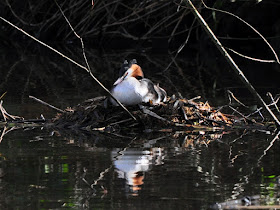 |
| It was interesting to see the German-ringed Black-headed Gull now that it is close to having a full brown hood. |
 |
| Hood development of the German ringed Black-headed Gull IA141745. It is a shame I didn't photograph it in early February |
 |
| I nearly missed the drake Mandarin asleep on the bank. |
 |
| Although the Water Rail showed well it was often partially obscured by vegetation or was in the shade as in this photo. |
 |
| Eventually I got some photos in better light. |
 |
| Female Yellowhammer. Yellowhammers only take advantage of this food source in late winter and early spring and sometimes allow fairly close approach. |
 |
| Male Yellowhammer |
 |
| Male Yellowhammer |
 |
| I hadn't seen Moorhens feeding on the fence top before today. |
 |
| The fine weather stimulated many birds to sing and this Robins was in fine voice. |
 |
| The Mandarin was out on the water when I was making my way back home. |
 |
| I am not sure how long this Great Crested Grebe has been sitting but I think it has been at least a couple of weeks. |
 |
| Unringed male Siskin |
 |
| To cap off a good day the Belgian-ringed Blackcap showed well in the late afternoon. |
 |
| It spent more time feeding on the ground than it usually does and was eating the scraps that fall from the sunflower heart feeders and fat cakes. |







No comments:
Post a Comment